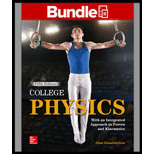
Concept explainers
(a)
Maximum and minimum upward force that the supporting cables exert on the elevator car.
(a)
Answer to Problem 72P
Maximum force is
Minimum force is
Explanation of Solution
Write the equation of force exerted by the supporting cables on the elevator car.
Here
Write the equation of force due to gravity
Here
Then the maximum force would be
The minimum force would be
Conclusion
Substitute
Substitute
Maximum force is
Minimum force is
(b)
Minimum time to ascent from the lobby to the observation deck.
(b)
Answer to Problem 72P
The time is
Explanation of Solution
Write the expression to find the time taken to reach the maximum ascent speed.
Here,
Write the expression to find the distance covered during acceleration.
Here,
Write the expression to find the distance covered.
Here,
Conclusion:
Substitute
Vertical distance covered during this time is,
Substitute
Remaining vertical distance is,
Elevator moves with uniform speed to cover this distance.
Expression to calculate the time taken to cover this distance,
Substitute
The minimum time taken by the elevator to ascend from the lobby to the observation desk is,
Substitute
Therefore, the minimum time taken by the elevator to ascend from the lobby to the observation desk is
(c)
Maximum and minimum values of a passenger’s apparent weight during the ascend.
(c)
Answer to Problem 72P
The maximum weight during the ascent is
The minimum weight during the ascend is
Explanation of Solution
The maximum weight would be
Here
The minimum weight would be
Conclusion
Substitute
Substitute
The maximum weight during the ascent is
The minimum weight during the ascend is
(d)
Minimum time for the elevator to descend to the lobby.
(d)
Answer to Problem 72P
The time is
Explanation of Solution
Write the expression to find the time taken to reach the maximum decent speed.
Here,
Write the expression to find the distance covered during acceleration.
Here,
Write the expression to find the distance covered.
Here,
Conclusion
Substitute
Vertical distance covered during this time is,
Substitute
Remaining vertical distance is,
Elevator moves with uniform speed to cover this distance.
Expression to calculate the time taken to cover this distance,
Substitute
The minimum time taken by the elevator to ascend from the lobby to the observation desk is,
Substitute
Therefore, the minimum time taken by the elevator to ascend from the lobby to the observation desk is
Want to see more full solutions like this?
Chapter 4 Solutions
COLLEGE PHYSICS (LOOSELEAF)-W/CONNECT
 College PhysicsPhysicsISBN:9781305952300Author:Raymond A. Serway, Chris VuillePublisher:Cengage Learning
College PhysicsPhysicsISBN:9781305952300Author:Raymond A. Serway, Chris VuillePublisher:Cengage Learning University Physics (14th Edition)PhysicsISBN:9780133969290Author:Hugh D. Young, Roger A. FreedmanPublisher:PEARSON
University Physics (14th Edition)PhysicsISBN:9780133969290Author:Hugh D. Young, Roger A. FreedmanPublisher:PEARSON Introduction To Quantum MechanicsPhysicsISBN:9781107189638Author:Griffiths, David J., Schroeter, Darrell F.Publisher:Cambridge University Press
Introduction To Quantum MechanicsPhysicsISBN:9781107189638Author:Griffiths, David J., Schroeter, Darrell F.Publisher:Cambridge University Press Physics for Scientists and EngineersPhysicsISBN:9781337553278Author:Raymond A. Serway, John W. JewettPublisher:Cengage Learning
Physics for Scientists and EngineersPhysicsISBN:9781337553278Author:Raymond A. Serway, John W. JewettPublisher:Cengage Learning Lecture- Tutorials for Introductory AstronomyPhysicsISBN:9780321820464Author:Edward E. Prather, Tim P. Slater, Jeff P. Adams, Gina BrissendenPublisher:Addison-Wesley
Lecture- Tutorials for Introductory AstronomyPhysicsISBN:9780321820464Author:Edward E. Prather, Tim P. Slater, Jeff P. Adams, Gina BrissendenPublisher:Addison-Wesley College Physics: A Strategic Approach (4th Editio...PhysicsISBN:9780134609034Author:Randall D. Knight (Professor Emeritus), Brian Jones, Stuart FieldPublisher:PEARSON
College Physics: A Strategic Approach (4th Editio...PhysicsISBN:9780134609034Author:Randall D. Knight (Professor Emeritus), Brian Jones, Stuart FieldPublisher:PEARSON





